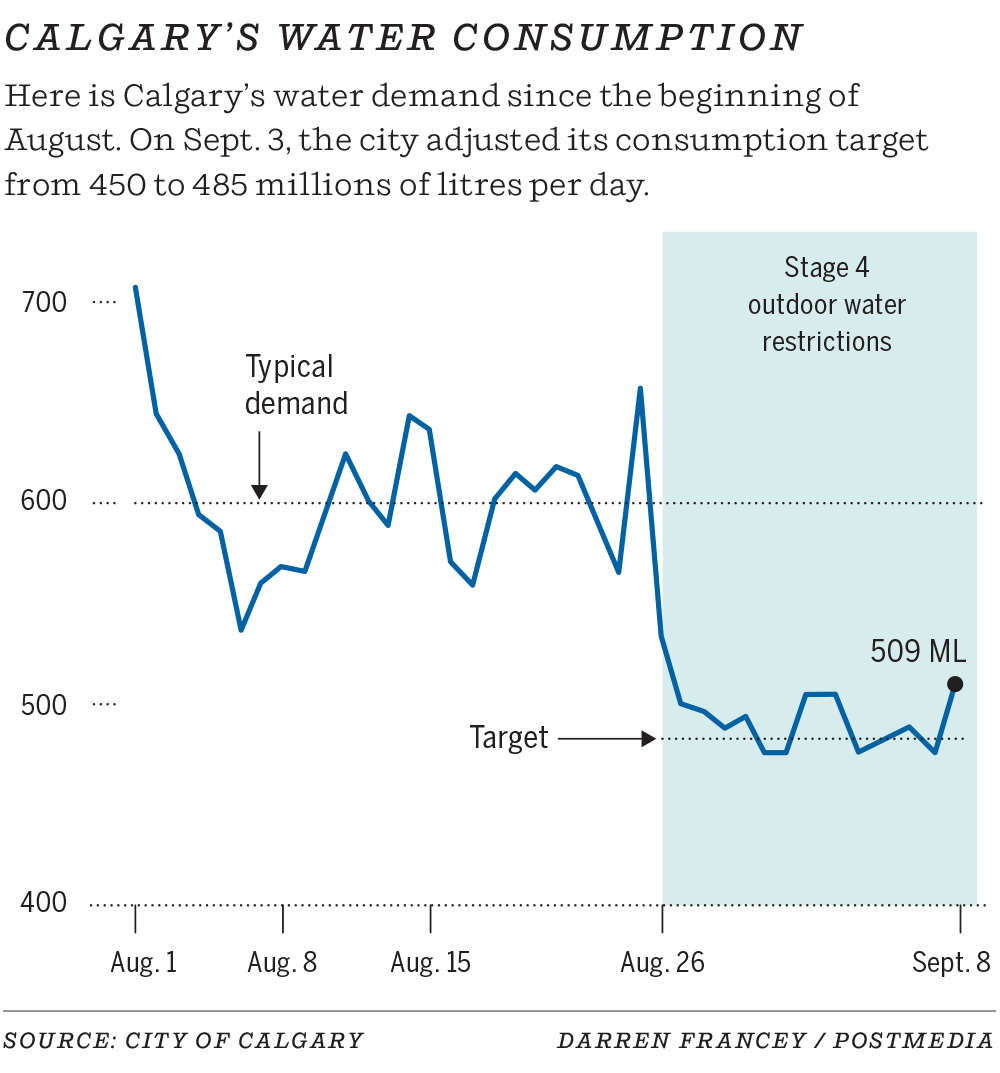Breadcrumb Trail Links
NewsLocal NewsPoliticsOpinionColumnists
Calgarians deserve clear descriptions of the failure scenarios
Article content
Eight city councillors lined up with Mayor Jyoti Gondek Monday to plead for cuts in water use; a morose crew who know the city is tiptoeing around disaster every day.
If the overworked Glenmore water plant suddenly fails, 70 per cent of the remaining water supply goes offline.
It’s the truth, no matter what the don’t-comply agitators say.
But consumption is still about 10 million litres per day above the limit because many Calgarians aren’t convinced.
Advertisement 2
Article content
Gondek was asked why this is, when public compliance was so much stronger after the Bearspaw South Feeder line exploded on June 5.
She said the first round was more dramatic because the rupture was so visually riveting.
“This time around, because it’s maintenance and repair work, I think some folks are feeling this only affects Montgomery and Bowness,” Gondek said.
Maybe so, but it’s not the main problem.
City hall itself let the sense of crisis fade away when they called a weeks-long hiatus and Gondek went to Europe. (She was attending the World Energy Cities Partnership’s annual general meeting in Stavanger, Norway.)
Now they’re trying to reboot the original mood with the bureaucratic language that never calls a thing by its name.
We’re flirting with “crisis,” Gondek says, without describing the crisis in detail.
If the Glenmore plant shuts down, what exactly does that mean for people across the city?
Do we have to boil water at that point? Would there be any water at all? Would the whole system fail?
The mayor and officials are vague about all those crucial points. And they’re getting a vague response from Calgarians.
Article content
Advertisement 3
Article content

Personally, I think we’re on the edge of a disaster here. Continuing to miss daily targets for water cuts could lead the whole city into shortages or worse.
Calgarians deserve clear descriptions of the failure scenarios.
Tell us exactly what happens if that Glenmore plant breaks down during the final weeks of Bearspaw repairs.
That could cut water use in a hurry. But city hall offers the usual gushing thanks for all we’ve done, followed by assurance that repairs are going well.
They aren’t telling us the whole story. This is hardly new. I’ve talked to former city water officials who say they were routinely shut up by communications staff.
“They’re just awful,” says retired water engineer Roy Brander. “They don’t want you to explain things clearly to Calgarians and tell the whole truth.”
That happened at public meetings when he wanted to lay out clear facts but was shushed by staff.
The mayor and councillors also fail to talk about the long-term problem. The city does not have enough water pipeline capacity to service an area of 1.6 million people.
Recommended from Editorial

Water use spikes to unsustainable level as Calgarians asked to further curb consumption

Braid: City hall talked about the fix for water crisis for 30 years without doing it
Advertisement 4
Article content
After the Bearspaw work is done, more failures with citywide impact are almost inevitable. (The main Glenmore pipe hasn’t had a major breakdown – not yet — since it was installed in 1932.)
The answer to all this is a new water facility at Bearspaw, combined with a 22-kilometre line to service the city’s north side.
As I’ve written before, this line is approved by council and some work is already underway.
But the mayor and officials never talk about this hugely expensive project. It’s not even mentioned in the city’s most recent progress report.
Talking about this north line would raise questions about major blunders at city hall.
As outlined in a private report written by a retired official, which I’ve read, reorganization during the 2010s split up veteran water project teams and made their reporting lines incomprehensible. Focus shifted from doing the job to system survival.
This north project was stalled and finally cancelled in 2021. It was later replaced with the new design.
Even if this pipeline proceeds on schedule, which is unlikely, it won’t be in service until 2029. Until then, Calgary will be vulnerable to failures in the water supply.
For free, here’s the simple message we should be hearing right now: Using too much water means disaster for Calgarians, businesses and the economy.
Just stop.
Don Braid’s column appears regularly in the Herald
X: @DonBraid
Article content
Share this article in your social network













:max_bytes(150000):strip_icc()/Health-GettyImages-1498955417-9f25b759ebea42de90770bcbdda53d2f.jpg?w=120&resize=120,86&ssl=1)






